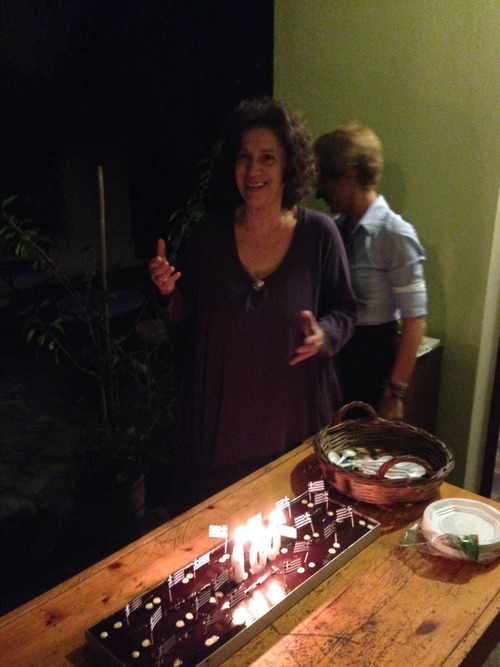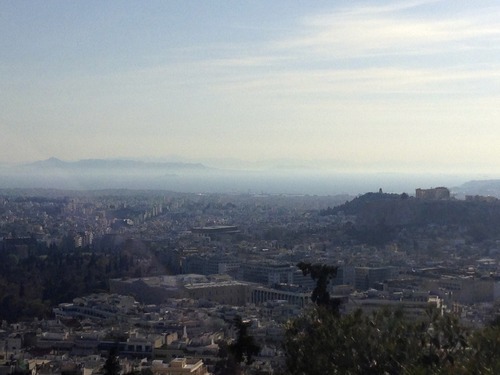More pictures from the donkey ride, hike to the church and watching the sunset in Fira.
Friday, April 18, 2014
Sophie, Lucy and I stayed at Perissa beach, where the sand was black and there was a nice strip of restaurants. It wasn’t crowded, but we had been told that Greeks who went to the beach on Santorini went there. The weather allowed us one nice afternoon on the black sand, which was perfect because although the wind was a bit chilly, the sand itself warmed us up.
Otherwise, we visited Fira where we rode the donkeys and Oia the next day. Supposedly, the distance from Fira to Oia is hike-able, but we chose to hike only a part of it to explore a cool looking area of the coast.
Most of these pictures are from that hike, and the next round should have some as well!
SANTORINI
From Monday to Thursday of this week, I was on Santorini with my friend Lucy from CYA and her friend from home, Sophie, who is currently studying abroad in England. It was as beautiful as everyone said it would be even though it wasn’t the season for visitors! The classic white-washed walls and blue domes and doors is exactly what we saw in the cities here.
On our first day we explored the town of Fira, rode donkeys up and down the mountainside for about a 30 minute ride and went on a nice hike. Fira was beautiful with winding streets, beautiful boutiques and nice cafes with views of the caldera. The donkeys were definitely fun, but much more unstable than we expected and the poor things were sweating bullets and it was only April! I can’t imagine how hard they are worked in the summer and I almost wish we hadn’t done it. But they looked like they were treated well enough! More pictures to come…the order is a bit scrambled.
AEGINA
On Sunday, I went on a day trip with Fiona to one of the nearby islands for my free day before going to Santorini. We had decided to go to the port, Piraeus, together, see the ferry schedules, pick an island and go. We had hoped to visit Hydra, but since the ferries were full, we ended up en route to Aegina, a major island only an hour ride from Athens. For some reason I had had some prejudice against going to Aegina for a day, but I was so pleasantly surprised and charmed!
We arrived and promptly found a café for lunch (since I had been up at 5 that morning and was starving) and wandered around the town for a half hour or so. The boutiques all had a style that somehow Athens lacks and really ought to have! Many of them had the decorated candles that Greeks use the night before Easter for the tradition of spreading the light that they fly over from Jerusalem. They fly the light over, then spread it through all the churches and from candle to candle so that everyone holds the same light originating from Jerusalem. The candles I saw were ornamented with symbols of different hobbies. When you give someone a candle as a gift, you give one that represents that person’s interests.
We found our way to the bus stop, but found out that we had missed the last bus to the other side of the island! Fiona and I had really wanted to see the temple to Aphaea (a local goddess who does not have any other temple aside from this one on Aegina) as well as a particular monastery. Luckily, we rented an ATV to share! It sprinkled a bit that day and wasn’t too sunny, so we froze a bit, but, again, driving around was a great way to see the island. We made it to the temple, another of the towns that was recommended (but it was basically a ghost town), and the monastery. I think both Fiona and I were surprised at how much we enjoyed this monastery. We have visited a few this semester with CYA, but something about this one or being there on our own was very special. Back in the port town, we had to buy some pistachios because Aegina harvests them there. All in all a great adventure day!
Saturday, April 12, 2014
Marinetta

Marinetta is my wonderful Greek teacher, and this past week our class went to her house for dinner. It makes me so happy to see her happy. She had her daughter and her two grandsons help out with serving us and playing the music that she wanted to teach us. She must have cooked for hours to prepare!
She always takes time to explain the Greek way of life and is so clearly proud of everything Greek. I love this window into Greek culture compared to what young people from cafes tell us. Obviously her perspective is a bit different, but I appreciate hearing her view of everything. She is definitely my favorite Greek.
More from Crete
My favorite part of the weekend in Crete was a stop in Margerites, a small village that specializes in ceramics. We stopped for coffee in the morning and for a demonstration at one of the workshops. The artist was energetic, clear (spoke English very well), passionate and talented. He showed us how their designs depend on engineering and demonstrated how to make these very clever salt and pepper shakers on the wheel. He explained this certain symbol on all of the pots that marks any piece of ceramics as a product of Margerites. We all went crazy buying things because it was so fun to see - I hope nothing breaks!
We visited a semi-active monastery, a sleepy beach town that was a favorite of hippies back in the day (Today is life; tomorrow never comes), and basically saw the beautiful scenery and ate delicious food! I had a whole plateful of snails because they are supposed to be great on Crete.
My last picture is with Vasso, the CYA coordinator for the trip. I adore her, along with everyone else on the program, and taking a picture with her has been on my bucket list. Check.
WEEKEND ON CRETE
The CYA trip to Crete was an amazing time! We saw the most important archaeological sites, like Knossos and Mallia, but we had plenty of free time in various small towns to stop for coffee or lunch and in Heraklion where our hotel was.
Some of these photos are from Knossos, which was mostly interesting to see because it was reconstructed (and not many sites are reconstructed). The pictures I have of wall paintings are the originals, which we saw in the museum at Heraklion, but they were copied and placed on the site as well. Mallia wasn’t reconstructed, so I got to see both approaches to a site in a single morning. I still can’t decide how I feel about it. I wish they could leave the site as it is, but build a reconstruction somewhere else as a museum where they could offer the experience of being in the fully built (or as much as is possible to reconstruct) palace. Knossos was also really cool because there were so many peacocks!! I’ve decided they are real life mythical creatures.
These pictures aren’t very organized - they’re from Mallia, Knossos, the museum, a beachside town where we stopped for lunch and Heraklion. The last is from Heraklion, but it deserves some explanation. My friend Lily has a disposable camera that she saves for only select pictures. We were at this bench and looking to use it for a picture so she suggested we lie upside down on the bench. These tourists in the picture were at the same spot taking pictures, LOVED the idea, took our picture doing it, came over and forced me to sit up to see how great of a picture it was on their camera, then insisted on taking the same photo themselves. So that’s how I have this picture!
Thursday, April 3, 2014
Mount Lykavettos

On the Sunday after returning from Thessaloniki, a few friends and I hiked Mount Lykavettos for the view, the cafe, and so that we could cross it off our bucket lists. This is one of only a few mountains that interrupt the relatively flat city of Athens, and you can see it from almost anywhere. The hike was short but steep and offered an amazing view. My picture shows the Acropolis and the sea behind it. We didn’t plan on staying for long, but at the top it was too beautiful to leave, so we ended up staying until well past sunset. One of my favorite afternoons!
More from the field trip to Thessaloniki and northern Greece
A walk through a fish market, one of the many beautiful churches we toured, Fiona on top of the world, and three pictures from the site that claims to be the school of Aristotle where he taught Alexander the Great.
Northern Greece
Pictures from our second field trip - this time we went to northern Greece, mainly to see Thessaloniki and Pella. The first picture is Mount Olympus, which we passed from the bus. It’s huge! At the port in Thessaloniki, the sky was perfectly clear, and the only thing in the sky that looked like clouds was actually the snow-capped top of Mount Olympus in the distance. The second picture is from a small tour we took at Ambelica on the drive up to Thessaloniki - this town is very small, but it was worth the stop because it had its own kind of Rennaisance in the 18th century when they discovered that they had the resources to manufacture and trade a special color of dyed cotton. The town educated their people in business and languages so they could trade successfully. This painting is from the house of one of the very influential families, and it shows the port of Istanbul. That was cool to see after revisiting Istanbul the previous weekend with my family!
Then I have a couple of pictures of the water at Thessaloniki, which is right next to a strip of nice bars and restaurants. We had much more free time on this trip than we had in the Peloponnese, so we were able to explore this area a lot!
While we were there, Thessaloniki was hosting its annual documentary film festival, with international documentaries playing all day. I got to see two documentaries, one on the hostage crisis in Tehran, and another on an American man who went to live with Pigmies in Africa. I also got to go on a walk through a certain neighborhood of Thessaloniki with a CYA professor who specializes in ethnography, so I learned a bit about the population exchange between Turkey and Greece a couple of generations ago. We also visited an art exhibit (I have a picture of it) featuring a photographer’s work on the crisis in Greece.
We spent about three days in Thessaloniki and one visiting Pella, the city where Alexander the Great and Phillip came from. The site itself was not particularly impressive, but it’s always cool to see where these people lived!
Subscribe to:
Comments (Atom)